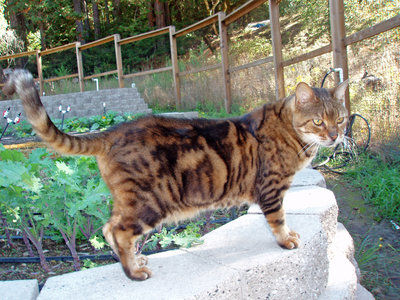
Editor’s note: This column continues Jan Nelson’s story of her visit to Lindencroft Farm. Read Part 1 at www.pressbanner.com or in the Oct. 28 edition of the Press-Banner.
Lindencroft Farm in Ben Lomond’s sand hills is a great example of a local family doing what they love and making a living, too. During a recent visit, you could see it in the new crop of Necores carrots just sprouting and being watched over by the family farm cat that was sitting on the edge of the retaining wall.
Linda Butler, who owns the farm with her husband, Steven, explained that the Necores is one of her favorite carrots, because she doesn’t have trouble with it forking, and it isn’t bothered by summer heat. Every crop that is grown on the farm is researched for best flavor and vigor.
Butler starts all her vegetables from seed and grows year-round. Some are started directly in the beds, while others are started in flats and transplanted later. She found that cole crops, such as broccoli, cauliflower and cabbage, would get eaten by bugs and birds as fast as they germinated, so those are started in flats instead.
Walking around, I saw many Italian names, as Butler specializes in Italian peppers. She gets seed from organic seed companies in this country, Italy and France. One of her favorite vegetables is rosa bianca eggplant, because it is almost never bitter. She also likes red Russian and lacinato kale, sometimes called dinosaur kale.
Tat soy and bok choy are favorites in the farm’s community-supported agriculture boxes. She also grows beans of all types, including french filet, romano and shelling beans. Golden beets (my personal favorite) and all kinds of potatoes — fingerlings, Russian banana, red thumb, German butter, red lasoda, and other heirlooms — grow underground. The beds overflow with life.
I tasted the last of the cherry tomatoes. Rosalita, a red grape type, was good, but the white cherry tomato was the best. Herbs grow in several boxes, and come spring, the farm can’t seem to grow enough asparagus to satisfy the demand.
Insect control is easy, Butler said. If fungal diseases persist, she plants a crop of beans, and that seems to solve it. Occasionally, aphids or spider mites get the upper hand, but rather than spray plants, even with organic soap, she finds she has better results by monitoring the plants often and cleaning the foliage with a hard blast of water, or cutting or pulling out infested plants. For her fava beans, which seem to always attract big black aphids, she harvests the beans and flowers while they are very young before aphids get a hold.
The farm is entirely powered by 78 solar panels. Recaptured rainwater is stored in a rainwater basin that holds a half a million gallons and is filtered twice before use. The Butlers collect this from just two to three good winter storms. Water from their own deep well is used in the beginning of the year, with the rainwater used in the hot summer months.
I asked Linda if the cool spring this year impacted her plants, and she said yes.
“Everything is three weeks late,” she said.
Our early October rains caused her tomatoes to get fungal diseased, so they had to harvest them all, while some of the squash now has powdery mildew and has to be pulled up early. As we were talking, she told some workers harvesting squash in another part of the farm to cut out the growing tips, so the remaining squash would receive all the energy of the plant to ripen before the weather turns cold. The sunflowers being visited by a flock of chickadees was looking a bit bedraggled, too.
We watched some workers putting up frames for plastic hoop houses that will protect pepper crops from the rains and extend the harvest this year. Even potatoes benefit from this cover, as overly wet soil contributes to fungal diseases. Lettuces, chard, kale and other leafy greens would get tattered by the rains if not covered.
Walking and talking, Butler would reach down and pick a sprig of bronze fennel or hyssop for me to enjoy. It’s clear that she is gentle on the earth and a good steward of the land. The entire farm is surrounded by redwood forest and oak meadowland that teems with wildlife.
Her philosophy of farming is to gently coax the best produce by creating as natural an environment as she can. Each year, the farm is healthier, more robust and more beautiful than the last.
To learn more about Lindencroft Farm, go to www.lindencroft.com.
Jan Nelson, a landscape designer and California certified nursery professional, will answer questions about gardening in the Santa Cruz Mountains. Email her at ja******@*ol.com, or visit www.jannelsonlandscapedesign.com to view past columns and pictures.











